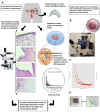An AFM-Based Nanomechanical Study of Ovarian Tissues with Pathological Conditions
- PMID: 32606681
- PMCID: PMC7311358
- DOI: 10.2147/IJN.S254342
An AFM-Based Nanomechanical Study of Ovarian Tissues with Pathological Conditions
Abstract
Background: Different diseases affect both mechanical and chemical features of the involved tissue, enhancing the symptoms.
Methods: In this study, using atomic force microscopy, we mechanically characterized human ovarian tissues with four distinct pathological conditions: mucinous, serous, and mature teratoma tumors, and non-tumorous endometriosis. Mechanical elasticity profiles were quantified and the resultant data were categorized using K-means clustering method, as well as fuzzy C-means, to evaluate elastic moduli of cellular and non-cellular parts of diseased tissues and compare them among four disease conditions. Samples were stained by hematoxylin-eosin staining to further study the content of different locations of tissues.
Results: Pathological state vastly influenced the mechanical properties of the ovarian tissues. Significant alterations among elastic moduli of both cellular and non-cellular parts were observed. Mature teratoma tumors commonly composed of multiple cell types and heterogeneous ECM structure showed the widest range of elasticity profile and the stiffest average elastic modulus of 14 kPa. Samples of serous tumors were the softest tissues with elastic modulus of only 400 Pa for the cellular part and 5 kPa for the ECM. Tissues of other two diseases were closer in mechanical properties as mucinous tumors were insignificantly stiffer than endometriosis in cellular part, 1300 Pa compared to 1000 Pa, with the ECM average elastic modulus of 8 kPa for both.
Conclusion: The higher incidence of carcinoma out of teratoma and serous tumors may be related to the intense alteration of mechanical features of the cellular and the ECM, serving as a potential risk factor which necessitates further investigation.
Keywords: atomic force microscopy; cellular and extra cellular matrix components; ovarian tumors; tissue elasticity.
© 2020 Ansardamavandi et al.
Conflict of interest statement
The authors report no conflicts of interest in this work.
Figures







References
MeSH terms
LinkOut - more resources
Full Text Sources
Miscellaneous

